Preiser W., Smith K.H. Universal Design Handbook
Подождите немного. Документ загружается.


40.2 EDUCATION AND RESEARCH
The camp facilities, many of which have been retrofitted from the 1950s, pose many obstacles,
some of which are dealt creatively, while others become part of the “camplike” atmosphere. Camp
Aldersgate is committed to adapting to the needs of each camper, while also fiercely dedicated to
maintaining a traditional camp experience, including rugged trails, natural terrain, and secluded set-
tings. From an experiential point of view, this is one of the best qualities of Camp Aldersgate. From
an accessibility mind set, this is one of the camp’s greatest challenges.
40.3 DRAMATIC SITES DEMAND ACCESSIBILITY
Site design is one of the most abstract components of any hypothetical studio project. At Camp
Aldersgate, the site is the protagonist and must be addressed from the beginning in order for designs
to be functional and successful. Two of the most successful projects at Camp Aldersgate—the tree
house and the stage and amphitheater—provided creative solutions while celebrating the unique
character of the place. As a result, the site and projects are so closely linked that without one, the
other would not be as interesting. For the tree house, completed in 2003, and the stage and amphi-
theater, completed in 2005, site and accessibility issues were solved creatively and opened two areas
of camp that had previously been unusable.
The Tree House
The primary challenge of any tree house lies in getting from the ground into the tree. Add acces-
sibility into the equation, and the problem is exponentially more difficult. The site for the tree house
was chosen for its dramatic slope, enabling a bridge to extend 40 ft from the natural dam of the lake,
resulting in a height of 22 ft above ground. A tree house of over 20 ft is memorable for almost any-
one, but for a child who relies on a wheelchair or crutches, the experience of being off the ground
and among the treetops is exhilarating. Although the structural aspect of building the tree house was
a daunting task, the students immediately appreciated the experiential possibilities. Their discrete
design creates open views to the lush landscape, so the tree house becomes a space through which
nature is viewed and experienced. A distinct vertical composition camouflages the tree house among
the tall tree trunks, and the lush green site obscures the tree house from the approach, making the
discovery of the project an experience in and of itself (see Fig. 40.1).
Orienting the tree house to frame-specific views is another example of the keen observation of
the students and their desire to celebrate the natural beauty of the site for the campers to witness.
In the heat of Arkansas summers, the tree house captures the gentle breezes from the lake and is a
haven from mosquitoes. Since 2003, the tree house has been the beginning of the nature course and
is now filled with leaves, sticks, pinecones, and other natural “treasures” that have been collected
by campers over the years.
In the case of the tree house, the steeply sloping site was both the problem and the solution.
The simplicity of the project is its strength: a single bridge that delivers campers into a 300-ft
2
tree
house. The inclusive nature of the tree house is not limited to young campers. Camp Aldersgate also
has a seniors program, and the tree house is a favorite respite for octogenarians, who spend each
Thursday at camp, fishing, canoeing, and being a kid again. The bridge equalizes the experience
for all campers, regardless of ability or age, with a hidden approach, distinct views, and a sense of
being in the trees.
The Stage and Amphitheater
The goal for the project in 2005 was to create an accessible stage and amphitheater with seating for
75 campers for weekly campfires, marshmallow roasting, and talent shows. A site near the lake was
chosen for its scenic view, which became the backdrop for the stage, and its gentle, natural slope,
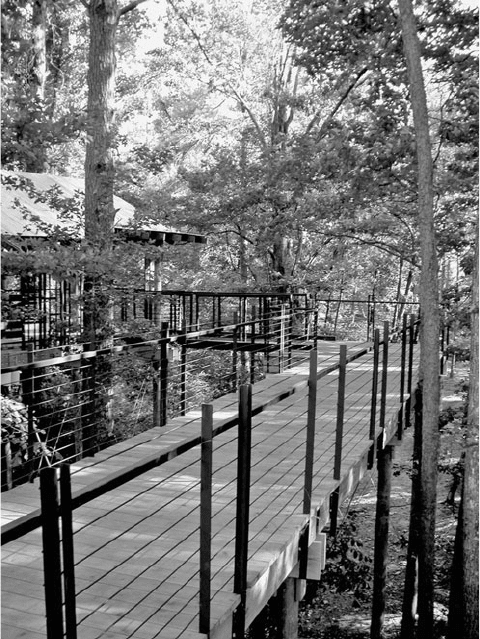
CAMP ALDERSGATE: A NEW MODEL FOR ARCHITECTURAL EDUCATION 40.3
which became the seating area. The site was also located off one of the main camp trails, making it
easy to access, but still providing an element of discovery. The site was filled with small trees and
some larger specimen trees, thereby providing a canopy for blocking the summer sun. Lake breezes
are funneled across the stage and into the seating in the evenings.
The primary challenge was the seating. The makeup of each week of camp is different. During
some weeks, the majority of campers use wheelchairs, while other weeks no campers use wheel-
chairs. This means that in any given week more or less fixed seating is needed. The students stud-
ied the site, pulled strings from trees to find the best sight lines, and created gently curved rows
of seating. The natural slope of the site created tiers for the rows, providing unobscured views of
the stage. Benches in 3-, 5-, and 6-ft lengths were spaced with 5 ft between them, so campers in
wheelchairs could fill in the seats. To accommodate more campers, steel and cedar bench caps were
designed to span from one bench to the other. This low-tech solution added an additional 20 seats
(see Fig. 40.2).
FIGURE 40.1 The entry to the tree house is a 40-ft bridge providing uni versal
access to the tree house which stands 22 ft above the ground.
Long description: This photograph shows the 40-ft bridge that allows one
ac cess to the tree house. The bridge is the only entry offering all campers,
regardless of ability, the opportunity to experi ence a tree house that is 22 ft
above the ground.
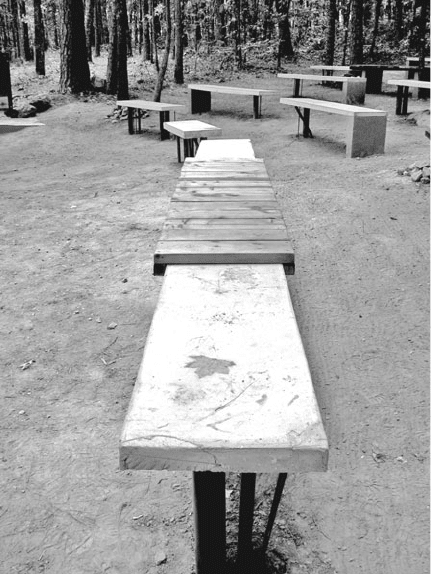
40.4 EDUCATION AND RESEARCH
The stage presented its own challenges. Keeping the stage low to the ground meant the view to
the lake would be preserved, but it would also be easier for campers in wheelchairs to access the
stage. Once the stage was sited and basic construction began, the students realized the back corner of
the stage was 3 ft off the ground. This meant a 36-ft ramp was needed to access the stage. Ramps are
rarely an interesting experience, and more times than not, they seem like an afterthought. Students
surveyed the site and realized that 36 ft from the stage created both a level and ideal entry sequence.
Because of the slight slope of the site, the ramp was level: a bridge. In plan, the bridge is armlike,
reaching out to enclose the seating. A second, smaller bridge allows campers to exit the other side
of the stage, and it, too, captures and encloses the seating (see Fig. 40.3).
As they do with the tree house, all campers enter the stage via a bridge on the night of the tal-
ent show. From the path at the back of the amphitheater, campers can negotiate the sloping site and
choose where to sit and, more importantly, by whom to sit.
The tree house and stage and amphitheater projects required thoughtful and creative situating to
maximize the experience, while integrating issues of accessibility. A bridge for the entry means all
campers have the same experience, since the ritual procession is part of the activity. These two proj-
ects blur the line between accessibility and good design: Are they good because they are accessible?
Or are they accessible because they are well designed? The students argue they are both.
FIGURE 40.2 The steel and cedar benches span the permanent, con-
crete benches to create additional seating when needed.
Long description: This photograph shows how the steel and cedar
benches span the permanent seating to create additional seat ing when
needed. These can be removed to allow campers using wheelchairs to
more freely move through the amphi theater.

CAMP ALDERSGATE: A NEW MODEL FOR ARCHITECTURAL EDUCATION 40.5
40.4 ORDINARY SITES DEMAND CREATIVE DESIGN
The previous section described the benefits of dramatic sites for creating extraordinary experiences.
With a more ordinary, flat site, the design must create the drama in order to heighten the sensory
experience. Two projects—the Archery Pavilion and the Picnic Areas, the first and the most recent
projects, respectively, at Camp Aldersgate—operate this way.
The Archery Pavilion
In 2002, the inaugural project of the Camp Aldersgate Design-Build program was to design an
archery pavilion. A site was chosen for its proximity to one of the main camp trails but also for its
secluded quality. The students responded to the L-shaped site by locating the pavilion to maximize
FIGURE 40.3 The site diagram shows the relationship of the stage to the entry bridge and
the seating.
Long description: The site diagram reveals the careful arrangement of the seating to maximize
view and accessibility. The entry to the stage is via a 36-ft bridge. A shorter bridge on the far
side of the stage provides another way to enter or exit the stage.
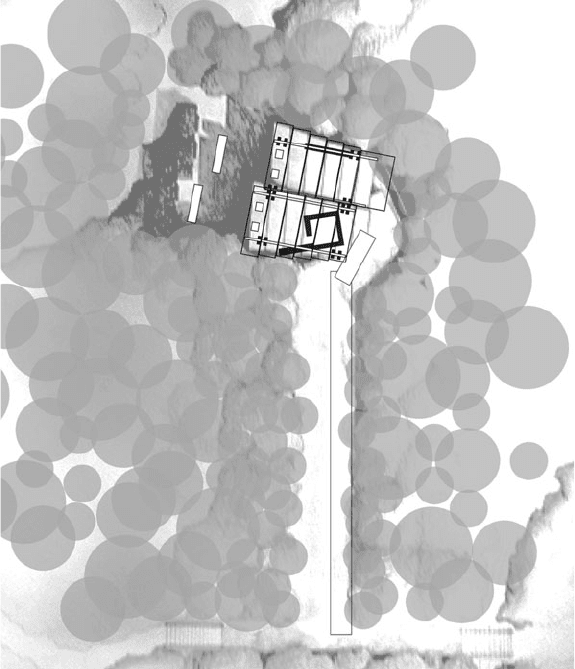
40.6 EDUCATION AND RESEARCH
the experience of discovery. A stone path intersects the main trail and leads one to the back of the
pavilion. From this perspective, the four accessible shooting stations are revealed to the campers.
A louvered wall shields the stations from the path, so they are not discovered until the pavilion is
entered (see Fig. 40.4).
The experience of discovery is important in the projects of Camp Aldersgate. After observing the
campers with muscular dystrophy, the students realized that many campers have little or no mobility,
so other kinds of interactive or sensory experiences were necessary. Color and textures are important
design elements in the archery pavilion. The shooting stations, designed from discarded car parts,
old bicycles and other found objects are the highlight of the experience. Campers can choose which
station they want to use and watch as the station is adjusted to their height, whether in a wheelchair
or standing. The stations also allow for the bow to be used crossbow-style, further expanding the
range of accessibility (see Fig. 40.5).
FIGURE 40.4 The site diagram shows the L-shaped site that creates an extended entry
sequence into the Archery Pavilion.
Long description: The Archery Pavilion makes use of an L-shaped site to create a dramatic
entry sequence. A long path leads one to the back of the pavilion, and a louvered wall conceals
the archery shooting stations from view.
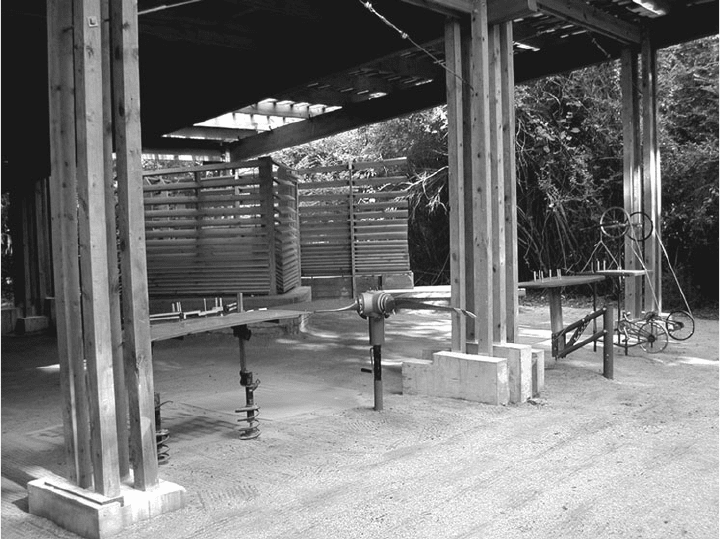
CAMP ALDERSGATE: A NEW MODEL FOR ARCHITECTURAL EDUCATION 40.7
The stations, in many ways, represented the deep understanding of accessibility gained by the
students. Through observation of the range of abilities of the campers, the students designed a
functional, experiential, and accessible component to the archery pavilion. The stations celebrated
the philosophy of the camp and solved a real accessibility issue with a creative, “outside the box”
solution.
Picnic Areas, Phase 2
In the summer of 2008, two picnic areas were designed to expand on the camp’s accessible gathering
spaces. A large site was selected for its beautiful, wooded setting and proximity to another one of the
main trails. The camp requested that the two sites be physically connected, but also visually inde-
pendent. The students began their investigation of the site by observing the light throughout the day,
walking the site to determine the best location and views, and tagging significant trees that would be
part of the experience. A natural drainage ditch ran through the site, creating an obstacle in the path
that needed to be addressed. The solution was simple but dynamic: a boardwalk that winds through
the woods, delivering campers to the two sites and creating a direct path from one trail to another
at the top of the site. The boardwalk is the only way the sites can be accessed so the experience is
one shared by all campers regardless of ability (see Fig. 40.6).
The boardwalk is level, so the ground falls and rises underneath it. In one place, the boardwalk
is 6 ft off the ground, in other places, only a few inches. This change in the ground plane is part of
FIGURE 40.5 The four, adjustable shooting stations are unique in their de sign and adapt to all campers.
Long description: The four, adjustable shooting stations are created from found objects like old bicycle and car parts,
an airplane propeller, and a basketball goal. Each station raises and lowers to ac commodate campers of all sizes and can
be used with a cross-bow to accommodate all abilities.
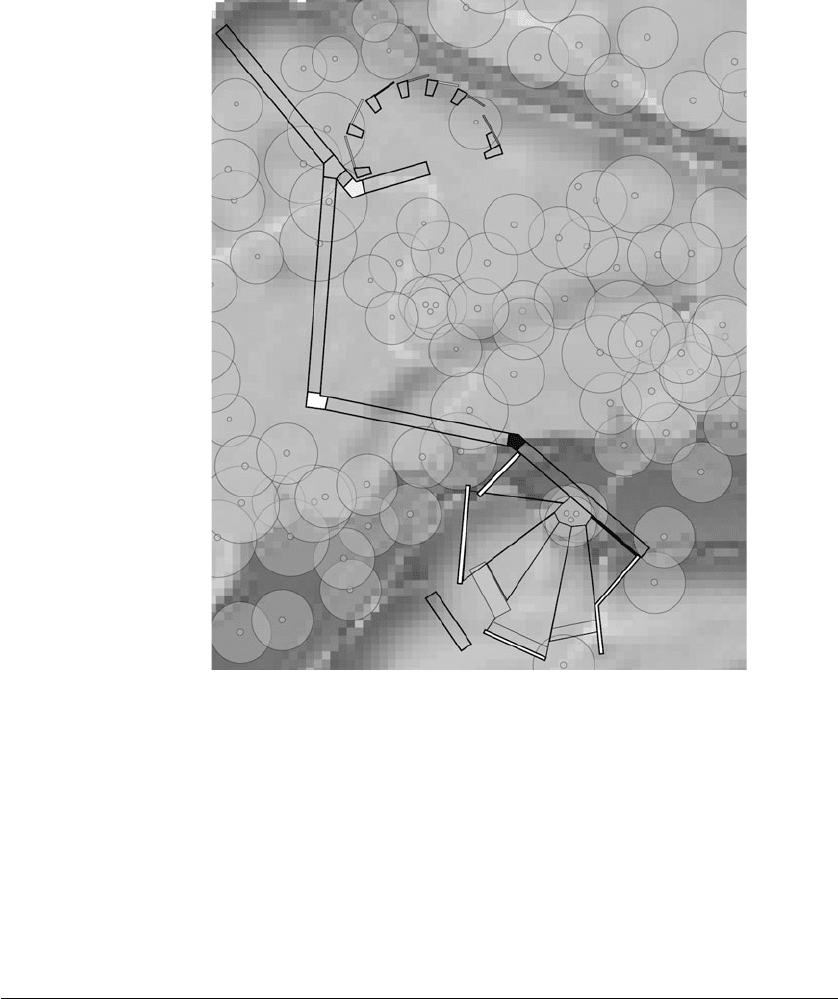
40.8 EDUCATION AND RESEARCH
the experience, as the path winds through the trees, turning to frame specific views. The two sites,
designed by separate groups of students, are unique to their relative locations, one focused inward,
the other, closing off an area but framing specific views out into the landscape. For this reason,
the two sites have become favorite gathering places for different camp activities. The enclosed site
prevents campers from being distracted by other activities, and the other site offers great views for
observing nature. The real success of this project is the multiple ways in which it can be adapted to
the camp’s various needs.
40.5 THE REALITY OF ACCESSIBILITY
One of the greatest challenges of the camp and the Camp Aldersgate Design-Build program is the
ground surface. The camp has avoided paving every surface in an effort to maintain a camplike
atmosphere: the natural setting is a significant part of any summer camp experience. But the different
FIGURE 40.6 The site diagram shows how the boardwalk creates a path that connects
the two picnic areas.
Long description: The boardwalk connecting the two projects creates a unique experi-
ence through the woods. Each site is accessible from the boardwalk.
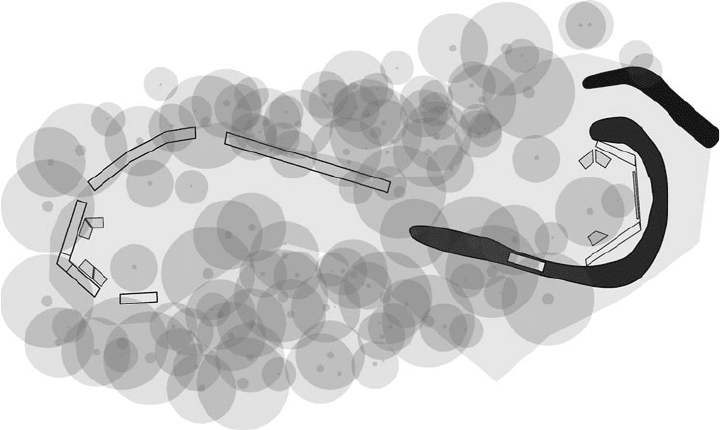
CAMP ALDERSGATE: A NEW MODEL FOR ARCHITECTURAL EDUCATION 40.9
surfaces are challenging from an accessibility standpoint, as well as a functional one. Drainage and
run-off are a constant battle for the facilities manager.
For the design-build projects, with a limited budget, the ground plane is always the greatest chal-
lenge. Projects like the Tree House and the Stage used built elements that re-negotiated the ground
plane, but those projects had additional challenges. Other projects, like the Archery Pavilion and the
second Picnic Area, found ways to make the ground plane work. But the reality of accessibility does
not always conform to the demands of the site.
Picnic Areas, Phase 1
One of the most challenging projects was completed in the summer of 2008. The first two picnic
areas, though relatively small in scale compared to the other projects, encompassed the largest site
where campers would be directly in contact with the ground. The design was for an undulating,
curvilinear form, with benches that provided places for seating or lounging. The different heights of
the benches and the adjustable tables allow the camp counselors to accommodate the facilities for
their campers’ needs on a weekly basis. These qualities are the real success of the project. Where the
project suffers is the design of the ground (see Fig. 40.7).
Once the site was cleared of underbrush, the earth revealed a tangle of rocks, roots, and uneven
surfaces. Rocks were gathered and used to line formal pathways, but their removal left holes that
needed filling. Small pea gravel was chosen to cover the ground, but it was initially spread too
thickly, and a test with a wheelchair quickly exposed the flaws of that material choice. The majority
of the gravel that was spread was later raked up, leaving only a thin layer that provided traction, some
leveling, and enough cover to enhance the design. It worked, but not in the way some of the other
projects excel with respect to accessibility. The camp has learned to adapt, and the campers enjoy
the natural quality of the cedar benches. Still, from an accessibility standpoint, some flaws remain.
FIGURE 40.7 The organic quality of the Picnic Areas celebrates the natu ral setting.
Long description: The slope and composition of the site inspired the serpen tine design. The two separate sites are
designed differently, one, light and airy, the other, heavier and more rooted to the earth.

40.10 EDUCATION AND RESEARCH
The ground plane is essential for mobility, and this project does not address that issue successfully.
It is a lesson learned.
40.6 CONCLUSION
Design-build is difficult work, particularly in the Little Rock heat. Construction often falls behind,
due to rain or other delays, and long days make everyone tired and tempers raw. Every summer, a
new project creates new challenges, and different student groups deal with them differently. At the
end of each workday, students walk away from the site with a tangible account of their accomplish-
ments for the day. Memories of any arguments that took place during the day quickly fade as the
students part ways for the evening. The reality of what they are accomplishing is reinforced each
week at the closing ceremony for that week’s camp. Images of the campers canoeing, fishing, sliding
down the ropes course, and swimming made the students aware of the importance of their work. At
some point during each 10-week process, the students forget that they are architecture students. Their
original ideas, which were more academic than contextual, evolve into an architecture serving the
campers. Slowly the students realize the “place” of Camp Aldersgate, and their willingness to make
architecture specific to the campers and the context is apparent. They struggle to overcome their
personal beliefs about architecture, and instead, listen to, or at least observe, their clients, children
at camp who happen to have disabilities. The result of this realization is five projects that capture
the place and the spirit of Camp Aldersgate. The individual designer is absent in the work, but the
team members usually agree the project is better because of its collective design. Instead, the five
projects, designed by 36 different students over the course of six summers, weave a common thread
throughout the camp. The projects create new opportunities for the campers each summer and exist
within the camp landscape as if they have been there from the beginning. They are sensitive to the
experience of place and the making of memories, and where they do falter, they make up for it in
other ways.
The relationship between Camp Aldersgate and the University of Arkansas Department of
Architecture is unique. The camp benefits from acquiring new facilities each summer, and the
university benefits from an opportunity to educate students in a hands-on, service learning setting.
Each project serves a new role and teaches its own lesson. Upon completion of the Archery Pavilion,
one student stated, “The opportunity to build and create a fun environment for the campers was the
greatest reward. To see the children’s faces while they were using the pavilion had such an impact
on me. They made me realize you can achieve so much through architecture.” These are the rewards
of sweat.
40.7 BIBLIOGRAPHY
Dean, A. O., “Sam Mockbee: The Hero of Hale County,” Architectural Record, February 2001, pp. 76–82.
———, and T. Hursely, Rural Studio: Samuel Mockbee and an Architecture of Decency, New York: Princeton
Architectural Press, 2002, pp. 1–13.
40.8 RESOURCES
For additional information on Camp Aldersgate, see www.campaldersgate.net.

CHAPTER 41
ARE RETROFITTED WHEELCHAIR
ENTRIES SEPARATE AND
UNEQUAL?
Jack L. Nasar
41.1 INTRODUCTION
To comply with the Americans with Disabilities Act (ADA) (1990), many buildings were retrofitted
to make at least one entry accessible to people in wheelchairs. ADA called for “full and equal enjoy-
ment;” and as a civil rights act, it follows the precedent from Brown v. Board of Education (1954)
that “separate is not equal.” Do the retrofitted separate entries offer full and equal experiences when
compared to the older front entries? How do new “universally designed” entries fare? To answer
these questions, two studies were conducted. The first had a diverse sample of adults evaluate the
pleasantness of 31 entry routes (13 main, 13 retrofitted, and 5 accessible entries for new buildings);
and the second obtained responses to the same routes from a more diverse sample of people who use
wheelchairs or other aids to access buildings.
41.2 BACKGROUND
At a national conference on design research, wheelchair users had to go through the kitchen to access
events, even though hotel staff had claimed the hotel was accessible. In a limited sense, the hotel
was accessible to people in wheelchairs. They could get to events. But the separate access gave them
a different, and presumably less enjoyable, experience. Designers may design front entrances to
convey a special feeling of entry and to uplift the spirit. For example, Frank Lloyd Wright designed
entrances to lead people through a series of experiences—separating the entry from the street, con-
fining the entry path, and then opening it into a large space—a sequence that conveys surprise and
an uplifting sense of entry. Other building entries have ceremonial steps and distinctive treatment in
form, size, and detail to make the front door stand out. In contrast, retrofits to buildings to comply
with the Americans with Disabilities Act (1990) and to give people who use wheelchairs access
often use side or back doors not designed to convey a feeling of entry or to uplift the spirit. Even
people who do not use wheelchairs may need accessible entrances. People using various types of
walking aids may also use them. These retrofitted entries may give people who use them a separate
and unequal experience. The present study sought to test that hypothesis.
In terms of accessibility, the United Kingdom led the way covering accessibility in housing,
transportation, employment, and education in 1944 (Sandhu, 2001). In the United States, a series of
laws led to the Americans with Disabilities Act, which set minimum standards for accessible design.
41.1
